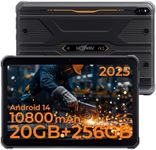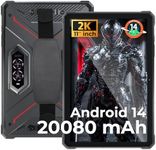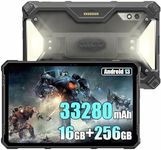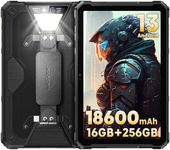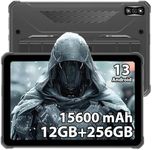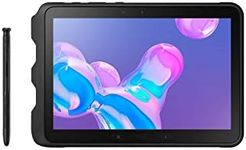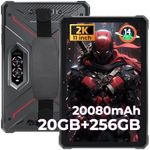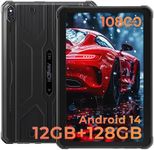Buying Guide for the Best Rugged Tablet
Choosing a rugged tablet is all about finding a device that can handle tough environments while still meeting your everyday needs. Rugged tablets are designed for durability, making them ideal for outdoor work, construction sites, field service, or any situation where a regular tablet might get damaged. When picking the right rugged tablet, it's important to look beyond just toughness and consider how the device will fit into your workflow, what features you need, and how you'll be using it day-to-day.Durability Rating (IP/MIL-STD)The durability rating tells you how well the tablet can withstand dust, water, drops, and other harsh conditions. The most common ratings are IP (Ingress Protection) and MIL-STD (Military Standard). IP ratings have two numbers: the first for dust protection and the second for water resistance. For example, IP68 means the device is dust-tight and can handle being submerged in water. MIL-STD-810G or 810H means the tablet has passed military-grade tests for drops, shocks, and temperature extremes. If you work in very tough environments, look for higher IP ratings (like IP67 or IP68) and MIL-STD certification. If your work is less demanding, a lower rating may be enough.
Screen Size and BrightnessScreen size affects how easy it is to view and interact with your tablet, while brightness determines how well you can see the screen outdoors. Rugged tablets come in various sizes, usually from 7 to 12 inches. Smaller screens are more portable and easier to hold, while larger screens are better for reading plans or maps. Brightness is measured in nits; higher numbers mean better visibility in sunlight. If you work outside a lot, look for a screen with at least 500 nits. Choose the size and brightness based on where and how you'll use the tablet most.
Battery Life and SwappabilityBattery life is crucial if you need your tablet to last through long shifts or remote work. Some rugged tablets offer batteries that last 8-12 hours or more, and some allow you to swap batteries without shutting down the device (hot-swappable batteries). If you spend long hours away from power sources, prioritize longer battery life and swappable batteries. If you only use the tablet for short periods or have easy access to charging, standard batteries may be sufficient.
Performance (Processor and RAM)Performance is determined by the processor (CPU) and the amount of RAM. A faster processor and more RAM mean the tablet can handle more demanding apps and multitasking. For basic tasks like note-taking or web browsing, entry-level specs are fine. For running specialized software, handling large files, or multitasking, look for higher-end processors and at least 4GB of RAM. Match the performance to the apps and tasks you expect to use most.
Operating SystemRugged tablets come with different operating systems, mainly Android, Windows, or sometimes iOS. The operating system affects what apps you can use and how the tablet fits into your existing workflow. If you need compatibility with Windows software or enterprise systems, choose a Windows tablet. If you prefer mobile apps and simplicity, Android is a good choice. Pick the OS that matches your work requirements and what you're already comfortable using.
Connectivity OptionsConnectivity options include Wi-Fi, Bluetooth, GPS, and sometimes cellular (4G/5G) or specialized ports (like USB, HDMI, or barcode scanners). If you need to stay connected in the field, look for tablets with cellular options. For navigation or location-based work, GPS is important. If you need to connect to other devices or accessories, check for the right ports. Choose the connectivity features based on how and where you'll use the tablet.
Weight and ErgonomicsWeight and ergonomics affect how comfortable the tablet is to carry and use for long periods. Rugged tablets are usually heavier than regular tablets due to their protective casing. If you need to hold the tablet for hours or move around a lot, look for a lighter model with good grip or hand straps. If the tablet will mostly stay in a vehicle or on a desk, weight may be less important. Consider how you'll carry and use the tablet day-to-day.
